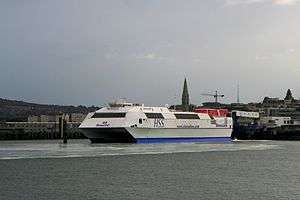HSS 1500
HSS 1500 was the name of a model of Stena HSS craft developed and originally operated by Stena Line on European international ferry routes. The vessels were the largest high-speed craft in the world. Several design patents were registered to Stena Line in the development of the HSS.
 Stena Explorer at Dún Laoghaire | |
| Class overview | |
|---|---|
| Name: | HSS 1500 |
| Builders: | Finnyards, Finland |
| Operators: |
|
| Built: | June 1994 - April 1997 |
| In service: | April 1996 - September 2014 |
| Planned: | 4 |
| Building: | 1996 |
| Completed: | 3 |
| Cancelled: | 1 |
| Laid up: | 1 |
| Retired: | 3 |
| Scrapped: | 2 |
| General characteristics | |
| Type: | High-speed catamaran |
| Tonnage: | 19,638 GT |
| Displacement: | 90.50 |
| Length: | 126.6 m (415 ft 4 in) |
| Beam: | 40.0 m (131 ft 3 in) |
| Draught: | 4.8 m (15 ft 9 in) |
| Depth: | 100m |
| Decks: | 7 |
| Deck clearance: | 30 min |
| Ramps: | 3 |
| Installed power: | |
| Propulsion: | 4x Kamewa Type S Waterjets |
| Speed: | Unladen record 51 knots |
| Capacity: |
|
| Notes: | The Stena Explorer is mainly laid up, it only sails in Summer now. |
Three vessels were ultimately completed in 1996 and 1997. The first of the class, Stena Explorer, entered service in April 1996, serving the Holyhead - Dún Laoghaire route[1] and As of 2014 remains the only one still in service. Two others had served Stranraer to Belfast and Harwich to Hoek van Holland.[2] On the 200-kilometre Hoek–Harwich route, the Stena HSS had cut the crossing time in half by cruising at 41 knots.[2][3]
Design and construction
Stena Explorer was constructed by Finnyards in Rauma, Finland.[4][5]
The HSS 1500 is a semi-small-waterplane-area twin hull (SWATH) catamaran, and was designed with the aim of providing a comfortable and fast service.[6]
Power is provided by four GE Aviation gas turbines in a twin COGAG configuration.[7] The vessels employ four Kamewa waterjets for propulsion.[1]
The HSS class of ferries were designed to allow quick turnarounds at port, in 30 minutes or less.[2] A specially designed linkspan for the Stena HSS provides ropeless mooring and allows quick loading, unloading and servicing. Vehicles are loaded via two of the four stern doors and park in a "U" configuration. When disembarking, vehicles drive straight off via the other two doors.[1]
Ships
- Stena Explorer (now: One World Karadeniz) - Sold for use as office space in Turkey
- Stena Voyager - scrapped in Sweden
- Stena Discovery (later: HSS Discovery) - scrapped in Turkey
References
- "Stena Explorer". Sealink-Holyhead. Retrieved 2009-12-24.
- "Fast Ferries", by Ian Manser, in The Global Change?, International Ports Congress 1999, page 43. Online at Google Books.
- "A Ferry for the Future", Bonaire Reporter, 2001-05-02. Retrieved 2011-10-25.
- "Stena Explorer". DNV Exchange. Det Norske Veritas. Retrieved 2009-12-24.
- "Stena Explorer" (in Swedish). Fakta Om Fartyg. Retrieved 2009-12-24.
- "The story behind the building of the first Stena HSS". Dun Laoghaire Harbour Company. Archived from the original on 2009-12-08. Retrieved 2009-12-24.
- "GE Marine Engines' LM Gas Turbines Exceed 600,000 Hours Operating Aboard 16 Fast Ferries" (Press release). GE Aviation. 2002-09-09. Archived from the original on 2010-12-11. Retrieved 2009-12-24.
Each semi-swath fast ferry has two LM1600 and two LM2500 gas turbines in a COmbined Gas and Gas (COGAG) turbine configuration.